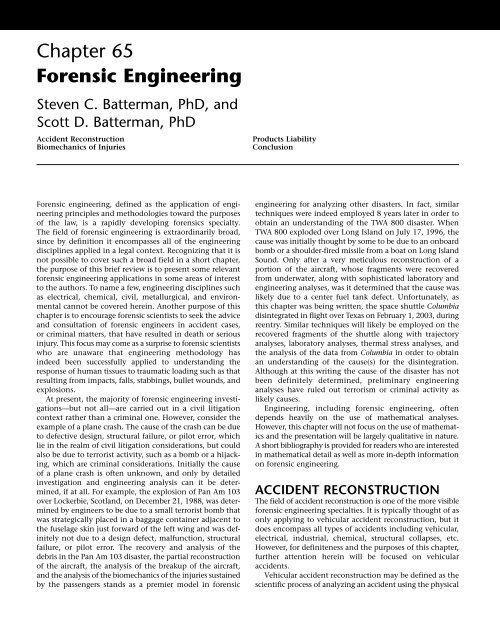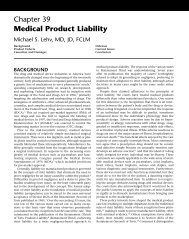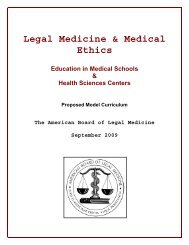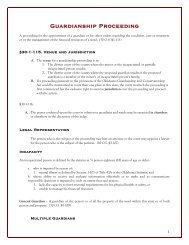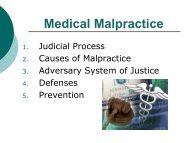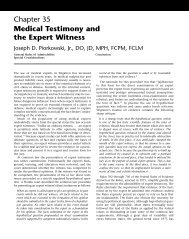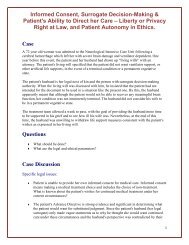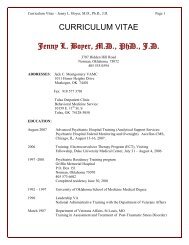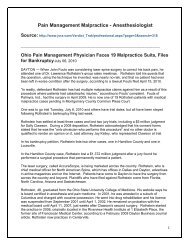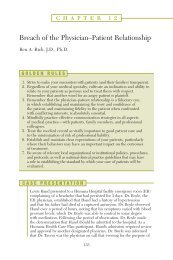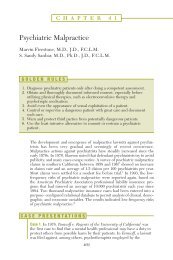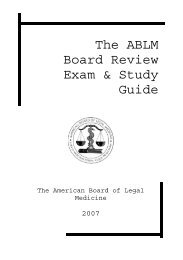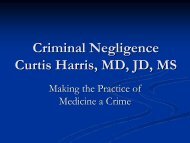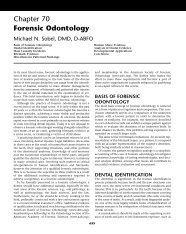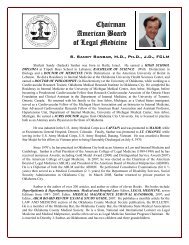Chapter 65 Forensic Engineering - Legal Medicine and Medical ...
Chapter 65 Forensic Engineering - Legal Medicine and Medical ...
Chapter 65 Forensic Engineering - Legal Medicine and Medical ...
Create successful ePaper yourself
Turn your PDF publications into a flip-book with our unique Google optimized e-Paper software.
Ch<strong>65</strong>-A03753 12/14/06 12:04 PM Page 609<br />
<strong>Chapter</strong> <strong>65</strong><br />
<strong>Forensic</strong> <strong>Engineering</strong><br />
Steven C. Batterman, PhD, <strong>and</strong><br />
Scott D. Batterman, PhD<br />
Accident Reconstruction<br />
Biomechanics of Injuries<br />
Products Liability<br />
Conclusion<br />
<strong>Forensic</strong> engineering, defined as the application of engineering<br />
principles <strong>and</strong> methodologies toward the purposes<br />
of the law, is a rapidly developing forensics specialty.<br />
The field of forensic engineering is extraordinarily broad,<br />
since by definition it encompasses all of the engineering<br />
disciplines applied in a legal context. Recognizing that it is<br />
not possible to cover such a broad field in a short chapter,<br />
the purpose of this brief review is to present some relevant<br />
forensic engineering applications in some areas of interest<br />
to the authors. To name a few, engineering disciplines such<br />
as electrical, chemical, civil, metallurgical, <strong>and</strong> environmental<br />
cannot be covered herein. Another purpose of this<br />
chapter is to encourage forensic scientists to seek the advice<br />
<strong>and</strong> consultation of forensic engineers in accident cases,<br />
or criminal matters, that have resulted in death or serious<br />
injury. This focus may come as a surprise to forensic scientists<br />
who are unaware that engineering methodology has<br />
indeed been successfully applied to underst<strong>and</strong>ing the<br />
response of human tissues to traumatic loading such as that<br />
resulting from impacts, falls, stabbings, bullet wounds, <strong>and</strong><br />
explosions.<br />
At present, the majority of forensic engineering investigations—but<br />
not all—are carried out in a civil litigation<br />
context rather than a criminal one. However, consider the<br />
example of a plane crash. The cause of the crash can be due<br />
to defective design, structural failure, or pilot error, which<br />
lie in the realm of civil litigation considerations, but could<br />
also be due to terrorist activity, such as a bomb or a hijacking,<br />
which are criminal considerations. Initially the cause<br />
of a plane crash is often unknown, <strong>and</strong> only by detailed<br />
investigation <strong>and</strong> engineering analysis can it be determined,<br />
if at all. For example, the explosion of Pan Am 103<br />
over Lockerbie, Scotl<strong>and</strong>, on December 21, 1988, was determined<br />
by engineers to be due to a small terrorist bomb that<br />
was strategically placed in a baggage container adjacent to<br />
the fuselage skin just forward of the left wing <strong>and</strong> was definitely<br />
not due to a design defect, malfunction, structural<br />
failure, or pilot error. The recovery <strong>and</strong> analysis of the<br />
debris in the Pan Am 103 disaster, the partial reconstruction<br />
of the aircraft, the analysis of the breakup of the aircraft,<br />
<strong>and</strong> the analysis of the biomechanics of the injuries sustained<br />
by the passengers st<strong>and</strong>s as a premier model in forensic<br />
engineering for analyzing other disasters. In fact, similar<br />
techniques were indeed employed 8 years later in order to<br />
obtain an underst<strong>and</strong>ing of the TWA 800 disaster. When<br />
TWA 800 exploded over Long Isl<strong>and</strong> on July 17, 1996, the<br />
cause was initially thought by some to be due to an onboard<br />
bomb or a shoulder-fired missile from a boat on Long Isl<strong>and</strong><br />
Sound. Only after a very meticulous reconstruction of a<br />
portion of the aircraft, whose fragments were recovered<br />
from underwater, along with sophisticated laboratory <strong>and</strong><br />
engineering analyses, was it determined that the cause was<br />
likely due to a center fuel tank defect. Unfortunately, as<br />
this chapter was being written, the space shuttle Columbia<br />
disintegrated in flight over Texas on February 1, 2003, during<br />
reentry. Similar techniques will likely be employed on the<br />
recovered fragments of the shuttle along with trajectory<br />
analyses, laboratory analyses, thermal stress analyses, <strong>and</strong><br />
the analysis of the data from Columbia in order to obtain<br />
an underst<strong>and</strong>ing of the cause(s) for the disintegration.<br />
Although at this writing the cause of the disaster has not<br />
been definitely determined, preliminary engineering<br />
analyses have ruled out terrorism or criminal activity as<br />
likely causes.<br />
<strong>Engineering</strong>, including forensic engineering, often<br />
depends heavily on the use of mathematical analyses.<br />
However, this chapter will not focus on the use of mathematics<br />
<strong>and</strong> the presentation will be largely qualitative in nature.<br />
A short bibliography is provided for readers who are interested<br />
in mathematical detail as well as more in-depth information<br />
on forensic engineering.<br />
ACCIDENT RECONSTRUCTION<br />
The field of accident reconstruction is one of the more visible<br />
forensic engineering specialties. It is typically thought of as<br />
only applying to vehicular accident reconstruction, but it<br />
does encompass all types of accidents including vehicular,<br />
electrical, industrial, chemical, structural collapses, etc.<br />
However, for definiteness <strong>and</strong> the purposes of this chapter,<br />
further attention herein will be focused on vehicular<br />
accidents.<br />
Vehicular accident reconstruction may be defined as the<br />
scientific process of analyzing an accident using the physical
Ch<strong>65</strong>-A03753 12/14/06 12:04 PM Page 610<br />
610 <strong>Forensic</strong> <strong>Engineering</strong><br />
facts <strong>and</strong> data left at the accident scene in conjunction<br />
with the appropriate natural laws of physics, i.e., the laws<br />
of classical mechanics stated by Sir Isaac Newton in 1687.<br />
The obvious is worth stating: Newton was not thinking<br />
about vehicular accident reconstruction since cars <strong>and</strong><br />
other modern vehicles were not going to be invented for<br />
more than 200 years. Although the laws of classical<br />
mechanics apply to the motion of all bodies in the universe,<br />
Newton was interested in planetary motion, concepts of<br />
gravity, <strong>and</strong> the development of the associated mathematical<br />
descriptions. With regard to accident reconstruction, the<br />
significance of this is that only qualified engineers <strong>and</strong><br />
physical scientists should be retained to do accident reconstructions,<br />
since they are generally thoroughly educated in<br />
underst<strong>and</strong>ing <strong>and</strong> properly applying the laws of physics.<br />
Caution is in order, since the advent of user-friendly computer<br />
programs <strong>and</strong> the codification of the laws of physics into<br />
“cookbook” type manuals have seen the entry of many less<br />
qualified people into the accident reconstruction field, which<br />
often does not serve the interests of truth <strong>and</strong> justice.<br />
General statements of Newton’s laws, which are formulated<br />
for a particle, are stated below, with more detailed<br />
information given in some of the references (Greenwood,<br />
Beer & Johnston, Yeh & Abrams):<br />
■ First law. Every material body continues in its state of<br />
rest, or of constant velocity motion in a straight line,<br />
unless acted upon by external forces that cause it to<br />
change its state of rest or motion.<br />
■ Second law. The time rate of change of linear momentum<br />
(product of mass times velocity) of a particle is proportional<br />
to the external force acting on the particle <strong>and</strong><br />
occurs in the direction of the force. An alternative form<br />
of this law, which is the more commonly stated form, is<br />
that the resultant force acting on a particle is equal to<br />
the mass times the acceleration.<br />
■ Third law. To every action there is an equal <strong>and</strong> opposite<br />
reaction. Or equivalently, the mutual forces of two bodies<br />
acting upon each other are equal in magnitude <strong>and</strong><br />
opposite in direction.<br />
Although Newton’s laws appear to be simple statements,<br />
it must be emphasized that there are significant concepts<br />
<strong>and</strong> sophisticated philosophy embedded in the laws,<br />
which must be mentioned <strong>and</strong> which are essential to an<br />
underst<strong>and</strong>ing <strong>and</strong> proper application of Newton’s laws.<br />
First, the laws are vector statements, which means that the<br />
magnitude <strong>and</strong> direction of forces, velocities, <strong>and</strong> accelerations<br />
must be considered <strong>and</strong> not merely their magnitudes.<br />
Second, “motion” <strong>and</strong> “rest” are relative terms that establish<br />
a frame of reference to which the motion of bodies is<br />
referred. For vehicular accident reconstruction calculations,<br />
the Earth is a suitable fixed reference. However, for space<br />
flights, rocket launchings, <strong>and</strong> general astronomical applications,<br />
the Earth would not be a suitable fixed reference<br />
<strong>and</strong> it would be more accurate to use a distant star. Third,<br />
Newton’s laws mention forces without ever defining them.<br />
Force is a very abstract concept <strong>and</strong> nobody has ever seen<br />
a force, which is the action of one body on another. In automobile<br />
accidents, apart from forces due to gravity, forces on<br />
occupants only arise when an occupant is decelerated<br />
(accelerated) such as by contacting another surface or is<br />
restrained by a seat belt, air bag, another person, etc.<br />
Fourth, Newton’s laws are stated only for a particle, which<br />
by definition is a mathematical point of constant mass. It<br />
requires a rigorous derivation to extend Newton’s laws to<br />
deformable bodies of finite size such as a crashing automobile.<br />
Unfortunately, this is often not appreciated by unqualified<br />
accident reconstructionists, who may tend to erroneously<br />
oversimplify an analysis. Fifth, the concept of systems of<br />
units is defined by Newton’s second law. In the SI system,<br />
mass is given in kilograms (kg), acceleration in meters per<br />
second squared (m/s 2 ), <strong>and</strong> force is the defined unit in<br />
Newtons (N), where one Newton equals one kg-m/s 2 .<br />
In the US–British system of units, force is given in pounds<br />
(lb), acceleration in feet per second squared (ft/s 2 ), <strong>and</strong><br />
mass is the defined unit in slugs, where one slug is equal to<br />
one lb-s 2 per ft.<br />
The general philosophy employed in accident reconstruction<br />
is to work backward from the final positions of<br />
the vehicle(s), to the point(s) of impact or beginning of the<br />
occurrence, <strong>and</strong> if sufficient information exists, prior to<br />
the impact(s) or occurrence. Calculations, either by h<strong>and</strong><br />
or by computer, are performed using the available data in<br />
conjunction with Newton’s laws. Often Newton’s laws are<br />
cast in other forms for convenience, such as the work–energy<br />
principle or impulse–momentum principle (see references<br />
previously cited). In collision problems at the moment of<br />
impact, the impulse–momentum principle is particularly<br />
useful since the resultant external force acting on the<br />
system of colliding bodies is zero. This then leads to the<br />
principle of conservation of linear momentum (product of<br />
mass times velocity), which states that the linear momentum<br />
of a system of colliding bodies is conserved at impact.<br />
This principle, combined with the information left at the<br />
accident scene <strong>and</strong> the vehicle data, is often sufficient to<br />
solve for the velocities of the vehicles at impact. Examples<br />
of the application of the principle of conservation of linear<br />
momentum, along with the associated vector concepts <strong>and</strong><br />
mathematics, are given in Batterman & Batterman (2000),<br />
Beer & Johnston, <strong>and</strong> the SAE Accident Reconstruction<br />
Technology Collection. It should also be mentioned that<br />
numerous commercially available computer programs exist<br />
for accident reconstruction calculations <strong>and</strong> these programs<br />
will not be discussed herein. The programs are based on<br />
Newton’s laws, as they must be, <strong>and</strong> many of them contain<br />
algorithms specialized for accident reconstruction, e.g., crush<br />
damage considerations. As indicated earlier, some of the<br />
programs are so user-friendly that it is possible for unqualified<br />
people, who do not have an adequate educational background<br />
<strong>and</strong> who do not underst<strong>and</strong> their own limitations<br />
as well as those of the programs, to obtain solutions that<br />
may not be valid for a particular accident.<br />
Another aspect of accident reconstruction, <strong>and</strong> undoubtedly<br />
the most difficult, is to determine how an occupant<br />
moves with respect to the crashing vehicle, i.e., the occupant<br />
kinematics. The determination of an occupant’s kinematics<br />
is often critically related to the injuries that may<br />
have been sustained by the occupant. In order to determine<br />
the complete occupant kinematics, an enormous amount
Ch<strong>65</strong>-A03753 12/14/06 12:04 PM Page 611<br />
Biomechanics of Injuries 611<br />
of physical information is required in addition to the complexities<br />
of solving a very difficult problem in dynamics.<br />
This physical information includes knowing the properties<br />
of the vehicle interior structures that may be contacted by<br />
the occupants, the actual contact points in the interior of<br />
the vehicle <strong>and</strong> on the occupant’s body, since this will then<br />
change the direction of motion of the occupant, the<br />
dynamic response of the human body to impact, <strong>and</strong> the<br />
details of how the vehicle is moving as a function of time.<br />
It is not surprising that in order to completely solve an<br />
occupant kinematics problem throughout the entire crash<br />
duration, an enormous amount of information is required as<br />
well as assumptions that may influence or bias the outcome.<br />
Sometimes only the initial occupant kinematics may be<br />
significant in an injury analysis, <strong>and</strong> this can often be<br />
determined without a complete occupant kinematics<br />
analysis. In general, an occupant initially tends to move<br />
toward the impact, which is opposite the change in velocity<br />
of the vehicle, referred to as delta-v, or opposite the resultant<br />
vehicle acceleration (see Batterman & Batterman, 2000).<br />
For example, in a frontal crash the occupants will tend to<br />
move forward with respect to the vehicle. If the occupants<br />
are unrestrained, front-seat occupants can impact the steering<br />
wheel, dashboard, or windshield while rear-seat occupants<br />
can impact the backs of the front seats. In a rear-end crash,<br />
occupants will tend to first move backward into their seats<br />
followed by a forward rebound phase. If unrestrained,<br />
occupants can then rebound forward into the vehicle<br />
structure in front of them while restrained occupants will<br />
not exhibit such large excursions. Another important<br />
aspect of rear-end collisions is that seat backs can fail, causing<br />
occupants to tumble into the rear of a vehicle <strong>and</strong> thus<br />
sustain serious injuries. In a lateral crash, nearside occupants<br />
to the crash will move toward the impact <strong>and</strong> may<br />
physically contact the impacting vehicle or a roadside<br />
object, such as a pole or a tree. Lap-shoulder belts worn by<br />
nearside occupants may not be effective in preventing<br />
injuries in this type of crash, but lateral air bags would<br />
offer some protection. However, a restrained farside occupant<br />
to a lateral crash may derive benefit from wearing a<br />
lap-shoulder belt, which would then limit occupant excursions<br />
toward the impact.<br />
BIOMECHANICS OF INJURIES<br />
Biomechanics, which simply means the application of<br />
Newtonian mechanics to biology, is a subfield of bioengineering,<br />
which can be defined as the application of engineering<br />
principles <strong>and</strong> methodology to biological systems.<br />
Bioengineering is a huge <strong>and</strong> rapidly developing field in<br />
the United States <strong>and</strong> worldwide, with burgeoning numbers<br />
of degree programs on the bachelors, masters, <strong>and</strong><br />
doctorate levels. The field of biomechanics is likewise vast,<br />
with applications beyond the vehicular considerations discussed<br />
in this chapter. For example, to name a few, biomechanicians<br />
are involved in the design of artificial organs,<br />
prostheses, bioinstrumentation, medical devices, safety<br />
devices such as protective sports equipment, automobile<br />
design <strong>and</strong> restraint system design to minimize injuries in<br />
a crash, as well as with underst<strong>and</strong>ing the response of tissues,<br />
cells, <strong>and</strong> biological systems to mechanical loading.<br />
Biomechanics of injuries has already been briefly mentioned<br />
when initial occupant kinematics was discussed.<br />
A complete discussion of injury biomechanics is beyond<br />
the scope of this chapter <strong>and</strong> instead only a few key ideas<br />
<strong>and</strong> concepts will be mentioned. The interested reader is<br />
referred to the bibliography, in particular the Stapp Car<br />
Crash Conference Proceedings <strong>and</strong> extensive literature<br />
available from the Society of Automotive Engineers.<br />
A concept that frequently appears in automotive injury<br />
biomechanics is that of delta-v, which is often correlated<br />
with injuries sustained in a crash. Delta-v is defined as the<br />
change in velocity (not speed) of a vehicle from its immediate<br />
preimpact velocity to its immediate postimpact<br />
velocity. Delta-v is a vector quantity, which has both magnitude<br />
<strong>and</strong> direction, <strong>and</strong> it is generally incorrect to merely<br />
subtract speeds in order to determine delta-v (see Batterman<br />
& Batterman, 2000). The major reason delta-v is correlated<br />
with injury potential is that delta-v is closely related to the<br />
vehicle accelerations in a crash <strong>and</strong>, by Newton’s second<br />
law, it is accelerations that determine the resultant forces<br />
acting on a system. However, it is emphasized that an occupant’s<br />
body or body segments, in general, will not experience<br />
the same delta-v as the vehicle. This is because vehicle <strong>and</strong><br />
body segment rotations can, <strong>and</strong> do, greatly influence the<br />
velocities <strong>and</strong> velocity changes an occupant may undergo<br />
in a crash.<br />
Correlations of injury with delta-v appear in the biomechanics<br />
literature (Mills & Hobbs) <strong>and</strong> are continuously<br />
being collected <strong>and</strong> updated. It should be noted at the outset<br />
that the correlations are statistical in nature, i.e., they<br />
give the probability of a certain type of injury occurring as<br />
a function of delta-v. Furthermore, to ensure uniformity<br />
<strong>and</strong> st<strong>and</strong>ardization of reporting, injuries are typically<br />
described utilizing the Abbreviated Injury Scale (AIS) promulgated<br />
by the Association for the Advancement of Automotive<br />
<strong>Medicine</strong> (AAAM). The AIS is based on anatomical injury<br />
immediately following the accident <strong>and</strong> does not score<br />
impairments or disabilities that may result from the<br />
injuries over time. A severity code is used in the AIS which<br />
ranges from 0 to 6, as shown in Table <strong>65</strong>-1.<br />
In the 1990 AIS, each injury is assigned a seven-digit<br />
code with six digits to the left of the decimal <strong>and</strong> one to<br />
the right. The digit to the right is one of the severity codes<br />
given above while the six digits to the left specify injury<br />
AIS<br />
Table <strong>65</strong>-1 AIS severity code<br />
Severity<br />
0 None<br />
1 Minor<br />
2 Moderate<br />
3 Serious<br />
4 Severe<br />
5 Critical<br />
6 Maximum (currently untreatable, fatal)
Ch<strong>65</strong>-A03753 12/14/06 12:04 PM Page 612<br />
612 <strong>Forensic</strong> <strong>Engineering</strong><br />
locations to the body region, type of anatomic structure,<br />
specific anatomic structure, <strong>and</strong> level of injury within a<br />
specific region <strong>and</strong> anatomic structure. The interested reader<br />
is referred to the detailed instructions for coding injuries<br />
given in AIS 90. Furthermore, other injury classification<br />
systems exist <strong>and</strong> are discussed by Pike.<br />
It is again worth emphasizing that injury correlations<br />
are statistical <strong>and</strong> are not absolute. For example, if there is<br />
a 60% probability of a certain type <strong>and</strong> injury severity<br />
occurring, this means that in the same crash there is a 40%<br />
probability of not sustaining that injury. In addition, a person<br />
can be critically injured or killed (AIS 5 or 6) in a moderate<br />
delta-v accident, say 15 to 20 m.p.h., but can walk away<br />
uninjured or with minor injuries (AIS 0 or 1) in a high<br />
delta-v accident, say 35 to 40 m.p.h. Hence, care <strong>and</strong> discretion<br />
must be used when the injury correlation data is to be<br />
used in an attempt to predict injuries in a given crash.<br />
It is also worthwhile mentioning a few other key ideas<br />
in the field of injury biomechanics. The concept of threshold<br />
injury criteria refers to those combinations of kinematic<br />
variables, i.e., related to geometry <strong>and</strong> motion, <strong>and</strong> kinetic<br />
variables, i.e., related to forces that cause the motion, which<br />
can cause a traumatic injury to various body tissues. These<br />
variables include, but are not necessarily limited to, forces,<br />
moments, or torques (rotational effect of forces), accelerations,<br />
stresses, strains, <strong>and</strong> their associated time histories.<br />
Time duration of loading (impulses <strong>and</strong> vibrations) can be<br />
very significant; for example, forces <strong>and</strong> accelerations<br />
applied for a short time period may not cause injury while<br />
the same forces applied for a longer time period may be<br />
injury-producing. In determining threshold injury criteria,<br />
an implicit assumption is made that such criteria do indeed<br />
uniquely exist <strong>and</strong> apply across the spectrum of the human<br />
population. This should be interpreted with caution, since<br />
not only is there expected biological variability between<br />
individuals, but factors such as age, disease, preexisting conditions,<br />
<strong>and</strong> other variables can <strong>and</strong> do influence the response<br />
of whole tissues <strong>and</strong> single cells to mechanical loading.<br />
The concept of threshold injury criteria has entered into<br />
the law. The National Traffic <strong>and</strong> Motor Vehicle Safety Act<br />
of 1966 introduced the concept of vehicle crashworthiness,<br />
i.e., the ability of a motor vehicle to protect its occupants<br />
in a crash. This act led to the creation of the Federal Motor<br />
Vehicle Safety St<strong>and</strong>ards (FMVSS), which require a minimum<br />
level of crashworthiness for all cars sold in the<br />
United States. The FMVSS contain essentially three threshold<br />
injury criteria (see Pike), which manufacturers must<br />
comply with <strong>and</strong> which are worth summarizing herein.<br />
The first, known as the Head Injury Criterion (HIC),<br />
requires that a certain mathematical expression, i.e., an<br />
integral of the resultant acceleration-time history measured<br />
at the center of gravity of the head of a restrained ATD<br />
(anthropomorphic test device) in a crash test, cannot<br />
exceed a value of 1000 or else the vehicle fails the test.<br />
There are many deficiencies in the HIC, which include the<br />
fact that it does not distinguish between types of head<br />
injuries such as skull fractures, subdural hematoma, diffuse<br />
axonal injury, <strong>and</strong> so on (see Newman). In addition, the use<br />
of a surrogate such as an ATD may not accurately reflect<br />
conditions necessary to cause human injury. However, the<br />
HIC may be useful as a screening device, in that a vehicle<br />
that results in a lower HIC may be better for head injury<br />
occupant protection than a vehicle that results in a higher<br />
HIC. The caveat here is that it is indeed possible to walk<br />
away from an accident with an HIC greater than 1000,<br />
without head injury, while a person can be killed by a head<br />
injury in a vehicle where the HIC was significantly less<br />
than 1000.<br />
The second criterion refers to a force measurement made<br />
in the femur of the restrained ATD. The vehicle fails the<br />
test if the force in the femur exceeds 10.0 kN (2250 lb).<br />
Again, the deficiency in this criterion is that femoral fracture<br />
loads are very variable <strong>and</strong> compressive fracture loads in<br />
human femora can be less than 2250 lb for a significant<br />
portion of the population.<br />
The third threshold injury criterion refers to the resultant<br />
acceleration measured at the center of gravity of the thorax<br />
of the ATD. A vehicle passes this test if the acceleration<br />
does not exceed 60 g’s (sixty times the acceleration due to<br />
gravity) for intervals whose cumulative duration is not<br />
more than 3 milliseconds (0.003 seconds). This criterion is<br />
an example of where the time duration of loading is significant.<br />
Again, a major shortcoming is that it does not<br />
account for normal population variability <strong>and</strong> does not<br />
distinguish between types of thoracic trauma such as rib<br />
fracture, transected aorta, etc.<br />
This section will be closed by noting that other injury<br />
criteria have been proposed <strong>and</strong> still others are undergoing<br />
intense research investigation. Biomechanics injury research,<br />
with its spinoffs to forensic engineering applications,<br />
requires the collaboration of engineers, medical<br />
researchers, <strong>and</strong> forensic scientists working toward the goal<br />
of underst<strong>and</strong>ing whole body <strong>and</strong> tissue responses to traumatic<br />
loading conditions.<br />
PRODUCTS LIABILITY<br />
Products liability is a burgeoning area of forensic engineering<br />
investigation. Products liability investigations revolve<br />
around the issue of whether a product is defective <strong>and</strong> if<br />
the defect is causally related to any injuries that may have<br />
occurred to the user(s) or people in the vicinity of the product.<br />
Essentially, the following three types of product defects are<br />
recognized in the law, but this may vary according to the<br />
jurisdiction of the lawsuit: (1) design defects, i.e., the product<br />
lacks those elements that are necessary for its safe <strong>and</strong><br />
foreseeable uses; (2) manufacturing defects, i.e., the product<br />
was not manufactured according to the manufacturer’s<br />
own specifications or st<strong>and</strong>ards; <strong>and</strong> (3) failure to properly<br />
warn or instruct the user in the proper <strong>and</strong> safe use of<br />
the product.<br />
If a forensic engineer is retained on behalf of the person<br />
bringing the lawsuit (the plaintiff), the engineer will objectively<br />
analyze the product for defects, <strong>and</strong> if they are<br />
found, will determine if the defects are causally related to<br />
the plaintiff’s injuries. The role of the forensic engineer<br />
retained by the defendant, which can often be the engineer(s)<br />
who designed the product, will be to objectively
Ch<strong>65</strong>-A03753 12/14/06 12:04 PM Page 613<br />
Products Liability 613<br />
defend the product in view of the allegations made by the<br />
plaintiff. As part of the defense of the product, the defense<br />
forensic engineer(s) may argue that the defect does not<br />
exist, <strong>and</strong>/or the plaintiff grossly misused the product,<br />
<strong>and</strong>/or that the plaintiff’s injuries are unrelated to the<br />
alleged defect. Products liability investigations can be very<br />
long <strong>and</strong> time-consuming <strong>and</strong> often require the expenditure<br />
of large sums of money for experts on behalf of both plaintiffs<br />
<strong>and</strong> defendants. They can also be very technically<br />
challenging, requiring a great deal of calculations, computer<br />
modeling, <strong>and</strong> laboratory testing.<br />
In order to fix ideas, the following examples are presented<br />
to illustrate the three types of defects mentioned<br />
above. These examples are obviously not intended to be<br />
exhaustive <strong>and</strong> are illustrative only.<br />
Design Defects<br />
Consider the phenomenon of vehicle rollover, which may<br />
occur during intended <strong>and</strong> foreseeable use of certain types<br />
of vehicles. For example, such vehicles can be all-terrain<br />
vehicles (ATVs), designed for off-road use, or sport utility<br />
vehicles (SUVs) designed for highway use as well as off-road<br />
use. <strong>Engineering</strong> analyses show that the rollover propensity<br />
of these vehicles is in large measure due to the high height<br />
of the center of gravity of the vehicle in relation to the<br />
track width, which are vehicle parameters under the control<br />
of the designer. A plaintiff may be driving an SUV on the<br />
highway <strong>and</strong> suddenly be forced into making a sharp turn<br />
or evasive maneuver to avoid an accident, which then leads<br />
to the vehicle rolling over, resulting in serious injuries or<br />
death to the SUV occupants. The rollover propensity may<br />
then form the basis for a design defect lawsuit, <strong>and</strong> many<br />
of these types of cases have indeed been litigated. It is also<br />
worth emphasizing that a design defect is an absolute concept,<br />
not a statistical one, <strong>and</strong> it is irrelevant that the same<br />
vehicle can be used successfully many, if not millions of,<br />
times without rolling over. Note that when TWA 800<br />
exploded, 747s had logged billions of passenger miles prior<br />
to the center fuel tank defect manifesting itself. When all<br />
physical conditions are satisfied, design defects can spell<br />
disaster for SUV occupants when the vehicle suddenly rolls<br />
over with little or no warning to the driver.<br />
Manufacturing Defects<br />
Simply because a person is injured using a product does not<br />
mean that a product defect of any kind exists. Sharp-edged<br />
instruments such as knives provide a good example since<br />
knives are designed to cut, <strong>and</strong> the fact that a person may<br />
be cut using a knife does not mean that the knife is defective.<br />
However, consider the situation where a person is using a<br />
knife to carve a turkey <strong>and</strong> during carving the blade fractures.<br />
This causes the person to lose balance, fall forward,<br />
<strong>and</strong> be stabbed by the fractured blade or, perhaps, another<br />
person in the vicinity was injured by a piece of the blade.<br />
Metallurgical analysis of the blade after the accident<br />
revealed that it was weakened by containing inclusions<br />
<strong>and</strong> by improper heat treatment during manufacture.<br />
This means that the blade was not manufactured according<br />
to the manufacturer’s own specifications <strong>and</strong> was thus<br />
defectively manufactured. Manufacturing defect lawsuits<br />
are much easier to pursue than design defect lawsuits since<br />
the entire product line, which may involve millions of<br />
products, is not at issue, but only the single defectively<br />
manufactured piece. However, considering the SUV design<br />
defect example above, jurors may have a difficult time<br />
underst<strong>and</strong>ing the physics <strong>and</strong> mathematics of rollover<br />
propensity, or even believing that the design defect exists,<br />
especially if they themselves drive SUVs.<br />
Failure to Warn<br />
Proper warnings <strong>and</strong> instructions can be critical to the safe<br />
use of a product. For example, properly designed car air<br />
bags can be wonderful life-saving devices in a crash.<br />
However, a person sitting too close to an air bag can be<br />
seriously injured or killed by the air bag front, which can<br />
move at speeds up to 320 km/h (200 m.p.h.), i.e., the person<br />
may have survived the delta-v of the crash but it was the<br />
deploying air bag that caused the serious injury or death.<br />
Small adults <strong>and</strong> children sitting in the front seat of an<br />
automobile are particularly vulnerable to impacts by the<br />
moving air bag front. If an automobile did not carry prominent<br />
warnings about sitting too close to a deploying air<br />
bag—<strong>and</strong> many cars did not when air bags were first introduced—the<br />
vehicle would be defective by virtue of a failure<br />
to warn. Furthermore, warnings should never be used by a<br />
manufacturer to disclaim liability, <strong>and</strong> in many cases a<br />
warning may be interpreted as an admission of a defect<br />
that was not designed out of the system. Hence, it is<br />
relatively common for allegations of defective design to be<br />
coupled with a failure to warn in a lawsuit complaint.<br />
For example, in air bag technology, air bags can be<br />
designed to be depowered such that the deploying front<br />
does not move as fast but still offers occupant protection<br />
without as high a risk of injury.<br />
General Product Design Considerations<br />
The goal of design engineering is to design safe products<br />
<strong>and</strong> systems that are free of hazards caused by defects.<br />
Engineers must be able to identify hazards in advance, or<br />
prospectively, <strong>and</strong> then design out the hazards, if it is practical<br />
<strong>and</strong> feasible to do so, before the product or system<br />
leaves their control. Once an accident due to a design<br />
defect occurs, the injured person has essentially identified<br />
the design defect <strong>and</strong> it is too late for a prospective hazard<br />
identification analysis. Several hazard identification analysis<br />
procedures, <strong>and</strong> variations of procedures, exist, which<br />
should be part of the normal design process <strong>and</strong> which are<br />
routinely employed by engineers in the design stages of a<br />
product or system to eliminate defects <strong>and</strong> improve system<br />
reliability. Three of the commonly used identification<br />
procedures are:<br />
■ Failure modes <strong>and</strong> effects analysis (FMEA).<br />
The FMEA is a bottom-to-top basic procedure where the<br />
system is examined component by component <strong>and</strong> a failure
Ch<strong>65</strong>-A03753 12/14/06 12:04 PM Page 614<br />
614 <strong>Forensic</strong> <strong>Engineering</strong><br />
or malfunction of any component is traced throughout the<br />
entire system. Flow sheets <strong>and</strong> computer programs are available<br />
to assist the engineering design team in this procedure,<br />
which screens the entire system. If the component failure<br />
results in a hazard that can cause injury, it is identified <strong>and</strong><br />
necessary design changes should be made to remove the<br />
hazard <strong>and</strong>/or protect the user.<br />
■ Fault-tree analysis (FTA).<br />
The FTA is a top-to-bottom procedure where the undesirable<br />
outcome (top event or fault condition) is the starting<br />
point. This top event is then traced down through the system<br />
<strong>and</strong> the failures of individual components or events that<br />
can lead to the undesirable outcome are identified. Design<br />
changes are then made as required to eliminate or minimize<br />
the probability of the occurrence of the fault condition.<br />
The FTA is a complicated procedure, which is used to analyze<br />
complex systems, e.g., a space shuttle; it relies heavily on<br />
Boolean algebra techniques <strong>and</strong> symbols <strong>and</strong> is most often<br />
done on a digital computer.<br />
■ Product safety audit (PSA).<br />
The PSA is basically a checklist containing hundreds,<br />
if not thous<strong>and</strong>s, of questions concerning the design of the<br />
product. The questions are framed in a manner such that a<br />
negative answer triggers further investigation, which may<br />
lead to a design change. The major drawback, as with any<br />
checklist procedure, is that if the list of questions is incomplete,<br />
a defect can be easily overlooked.<br />
Once the hazards in a product or system are identified<br />
by a proper hazard identification analysis, the engineer follows<br />
a codified procedure known as the “safety hierarchy”<br />
in order to prevent or minimize the probability of personal<br />
injury. This hierarchy is not a law of nature or a scientific<br />
law but rather a logical procedure that has been adopted by<br />
consensus <strong>and</strong> has the priorities shown in Table <strong>65</strong>-2, in<br />
the order in which they should be used.<br />
Typically, in products liability investigations applicable<br />
to consumer products, only the first three priorities are<br />
normally considered part of the safety hierarchy.<br />
Furthermore, the line between the first <strong>and</strong> second priorities<br />
can sometimes become blurred, depending on the product<br />
<strong>and</strong> its environment of use. This is because providing a<br />
proper guard can be thought of as an integral part of the<br />
overall design process, which includes considerations of<br />
man–machine interface safety in the concept stage <strong>and</strong> all<br />
design stages of product development. However, if the<br />
product is, say, a h<strong>and</strong>-held circular saw, the rotating blade<br />
First priority<br />
Second priority<br />
Third priority<br />
Fourth priority<br />
Fifth priority<br />
Table <strong>65</strong>-2 Safety hierarchy<br />
Design out the hazard if it is practical <strong>and</strong> fea<br />
sible to do so.<br />
If the hazard cannot be designed out, guard<br />
against the hazard.<br />
Provide proper warnings concerning the haz<br />
ards <strong>and</strong> instructions for use of the product.<br />
If applicable, provide training in the safe use<br />
of the product or system.<br />
If applicable, prescribe personal protective<br />
equipment.<br />
is essential to the cutting function <strong>and</strong> obviously cannot<br />
be eliminated. Hence, the second priority would call for a<br />
blade guard to protect against inadvertent contact with the<br />
blade. Whenever a design change is contemplated, it is<br />
essential that the engineer examine the alternative design(s)<br />
for new hazards which may be introduced by the change(s).<br />
The alternative design(s) may not be as safe as the original<br />
design <strong>and</strong> the engineer must decide on which features to<br />
include in the final design.<br />
Regarding warnings, it is important to emphasize that<br />
properly designed warnings, which can be words <strong>and</strong>/or<br />
pictographs, have to communicate three things to the user,<br />
i.e., what the hazard is, the steps the user can take to avoid<br />
the hazard, <strong>and</strong> what the likely consequences can be if the<br />
warnings are disregarded. Pictographs may be preferable to<br />
words since they can be more dramatic, in addition to<br />
eliminating a possible language barrier in locales where more<br />
than one language is commonly spoken. It should also be<br />
emphasized that too many warnings on a product may<br />
destroy their effectiveness. Furthermore, <strong>and</strong> very important,<br />
warnings should never be used by a manufacturer to disclaim<br />
liability <strong>and</strong> are never ever a substitute for a safe design<br />
that is practical <strong>and</strong> feasible to achieve.<br />
CONCLUSION<br />
The purpose of this short chapter has been to expose the<br />
reader to the exciting <strong>and</strong> rapidly developing field of forensic<br />
engineering. In addition, forensic scientists are encouraged<br />
to utilize the services of forensic engineers in injury <strong>and</strong><br />
death investigation cases. The topics discussed in the chapter<br />
are necessarily limited in scope <strong>and</strong> the interested reader is<br />
referred to the bibliography for references to further applications<br />
<strong>and</strong> in-depth treatments. The bibliography is provided<br />
for representative coverage of the field without endorsement<br />
of any publication. An attempt has been made to generally<br />
group the bibliography by subject matter, as discussed in<br />
the chapter, although there is considerable overlap.<br />
Bibliography<br />
<strong>Forensic</strong> <strong>Engineering</strong><br />
S.C. Batterman & S.D. Batterman, <strong>Forensic</strong> <strong>Engineering</strong>, in McGraw-<br />
Hill Yearbook of Science <strong>and</strong> Technology (2002).<br />
S.C. Batterman & S.D. Batterman, <strong>Forensic</strong> <strong>Engineering</strong>, in Medicolegal<br />
Death Investigation Manual: Treatises in the <strong>Forensic</strong> Sciences,<br />
2d ed., chap. 12 (<strong>Forensic</strong> Science Foundation Press, 1999).<br />
K.L. Carper (ed.), <strong>Forensic</strong> <strong>Engineering</strong>, 2d ed. (CRC Press, 2001).<br />
H. Petroski, To Engineer Is Human: The Role of Failure in Successful<br />
Design (St. Martin’s Press, 1985).<br />
N. Putchat, <strong>Forensic</strong> <strong>Engineering</strong>—a Definition, 29 J. <strong>Forensic</strong> Sci.<br />
375–78 (1984).<br />
Newton’s Laws <strong>and</strong> Principles<br />
of Classical Dynamics<br />
F.P. Beer & E.R. Johnston, Vector Mechanics for Engineers: Statics <strong>and</strong><br />
Dynamics (McGraw-Hill, 1977).<br />
D.T. Greenwood, Classical Dynamics (McGraw-Hill, 1977).<br />
H. Yeh & J.I. Abrams, Principles of Mechanics of Solids <strong>and</strong> Fluids:<br />
Particle <strong>and</strong> Rigid Body Mechanics (McGraw-Hill, 1960).
Ch<strong>65</strong>-A03753 12/14/06 12:04 PM Page 615<br />
Conclusion 615<br />
Accident Reconstruction<br />
Accident Reconstruction Technology Collection, CD-ROM (Society of<br />
Automotive Engineers, 2002).<br />
Accident Reconstruction: Human, Vehicle <strong>and</strong> Environmental Factors,<br />
SAE SP-814 (Society of Automotive Engineers, 1990).<br />
S.H. Backaitis (ed.), Reconstruction of Motor Vehicle Accidents:<br />
A Technical Compendium, PT-34 (Society of Automotive<br />
Engineers, 1989).<br />
S.C. Batterman & S.D. Batterman, Accident Investigation/Motor Vehicle<br />
(Accident Reconstruction <strong>and</strong> Biomechanics of Injuries), in J.A.<br />
Siegel et al. (eds.), Encyclopedia of <strong>Forensic</strong> Sciences (Academic<br />
Press, 2000).<br />
S.D. Batterman & S.C. Batterman, Delta-v, Spinal Trauma, <strong>and</strong> the<br />
Myth of the Minimal Damage Accident, 1(1) J. Whiplash & Related<br />
Disorders 41–52 (2002).<br />
T.L. Bohan & A.C. Damask (eds.), <strong>Forensic</strong> Accident Investigation:<br />
Motor Vehicles (Michie Butterworth, 1995).<br />
R.M. Brach, Mechanical Impact Dynamics: Rigid Body Collisions<br />
(Wiley, 1991).<br />
R. Limpert, Motor Vehicle Accident Reconstruction <strong>and</strong> Cause Analysis,<br />
2d ed. (Michie, 1984).<br />
Mathematical Simulation of Occupant <strong>and</strong> Vehicle Kinematics, SAE<br />
P-146 (Society of Automotive Engineers, 1984).<br />
Biomechanics of Injury<br />
The Abbreviated Injury Scale, 1990 revision (Des Plaines, IL:<br />
Association for the Advancement of Automotive <strong>Medicine</strong><br />
[AAAM],1990).<br />
Automotive Frontal Impacts, SAE SP-782 (Society of Automotive<br />
Engineers, 1989).<br />
Biomechanics of Impact Injury <strong>and</strong> Injury Tolerances of the Head-Neck<br />
Complex, SAE PT-43 (Society of Automotive Engineers, 1993).<br />
Biomechanics of Impact Injury <strong>and</strong> Injury Tolerances of the<br />
Thorax-Shoulder Complex, SAE PT-45 (Society of Automotive<br />
Engineers, 1994).<br />
A.C. Damask & J.N. Damask, Injury Causation Analyses: Case Studies<br />
<strong>and</strong> Data Sources (Michie, 1990).<br />
F.G. Evans, Mechanical Properties of Bone (Thomas, 1973).<br />
Human Tolerance to Impact Conditions as Related to Motor Vehicle<br />
Design, SAE J885 (Society of Automotive Engineers, 1986).<br />
J.H. McElhaney, V.L. Roberts & J.F. Hilyard, H<strong>and</strong>book of Human<br />
Tolerance (Japan Automotive Research Institute, 1976).<br />
P.J. Mills & C.A. Hobbs, The Probability of Injury to Car Occupants in<br />
Frontal <strong>and</strong> Side Impacts, in Proceedings of Twenty-Eighth Stapp Car<br />
Crash Conference, paper 841<strong>65</strong>2, 223–35 (Society of Automotive<br />
Engineers, 1984).<br />
A.M. Nahum & J. Melvin (eds.), The Biomechanics of Trauma<br />
(Appleton-Century-Crofts, 1985).<br />
J.A. Newman, Head Injury Criteria in Automotive Crash Testing, in<br />
Proceedings of Twenty-Fourth Stapp Car Crash Conference, paper<br />
801317, 703–47 (Society of Automotive Engineers, 1980).<br />
J.A. Pike, Automotive Safety: Anatomy, Injury, Testing <strong>and</strong> Regulation<br />
(Society of Automotive Engineers, 1990).<br />
Side Impact: Injury Causation <strong>and</strong> Occupant Protection, SAE SP-769<br />
(Society of Automotive Engineers, 1989).<br />
Stapp Car Crash Conference Proceedings, CD-ROM (Society of<br />
Automotive Engineers, 2002).<br />
Vehicle Crashworthiness <strong>and</strong> Occupant Protection in Frontal Collisions,<br />
SAE SP-807 (Society of Automotive Engineers, 1990).<br />
H. Yamada, Strength of Biological Materials (Krieger, 1973).<br />
Products Liability<br />
J.J. Phillips, Products Liability, 3d ed. (West Publishing Co., 1988).<br />
J.F. Thorpe & W.M. Middendorf, What Every Engineer Should Know<br />
About Product Liability (Marcel Dekker, 1979).<br />
A.S. Weinstein, A.D. Twerski, H.R. Piehier & W.A. Donaher, Products<br />
Liability <strong>and</strong> the Reasonably Safe Product: A Guide for Management,<br />
Design <strong>and</strong> Marketing (Wiley, 1978).<br />
Hazard Identification Analyses<br />
D.B. Brown, Systems Analysis <strong>and</strong> Design for Safety (Prentice-Hall,<br />
1976).<br />
B.S. Dhillon & C. Singh, <strong>Engineering</strong> Reliability, New Techniques <strong>and</strong><br />
Applications (Wiley, 1981).
Ch<strong>65</strong>-A03753 12/14/06 12:04 PM Page 616


